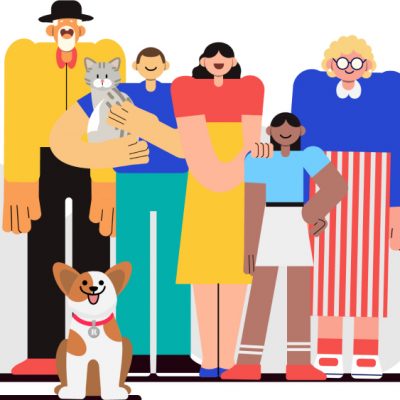Well-Being Guide

Mental Well-being
To better support our community, TikTok partners with experts to develop toolkits for everyone to learn more about improving their well-being, and to build a supportive online community.
Sharing Mental Health Stories

Here at TikTok, we understand that everyone has a unique story about mental health. We want to build a supportive environment for community members to share their experiences, tips and recovery journeys.
But mental health is not straightforward – there are ups and downs, new milestones and setbacks. We encourage you to connect with others meaningfully and remember, it’s not a competition.
This toolkit provides a few suggestions on how to talk about your mental health while keeping yourself safe and being respectful to other community members.
Are you ready to share?
Consider the right place and time to tell your story. Some questions you can think about before hitting “record”:
- What are my reasons for sharing?
- Am I ready to share my story with close friends and family only, or with a wider audience?
- Would sharing my story be helpful and not harmful to myself or others?
- In response to my post, others may share difficult stories with me or share opinions that could be hard to hear. Am I ready to support them and listen?
Sharing content that helps, inspires, and educates
If you are posting a tribute to a loved one who has died by suicide, experts offer these extra tips:
- Avoid sharing details and images about suicide tools, methods, location, notes, or messages. Such content can be distressing and/or accidentally give new ideas to struggling community members. Sharing details about suicide tools and methods is highly harmful, and such content will be removed from TikTok. This is very relevant for suicides by celebrities or well-known individuals. It could unintentionally glamorise suicide.
- Avoid using terms like “committed suicide”, “successful/ unsuccessful suicide”, “failed attempt”. “Committed” implies that suicide is criminal and attaches a stigma to it. This may discourage suicidal individuals from seeking help. It also affects people with loved ones who have lost loved ones in this way. Instead, say “died by suicide”. Terms like “successful” or “failed” frame suicide as a desirable outcome.
- Avoid portraying suicide as a glamorous, romantic, heroic, or practical option. Portraying suicide as a positive and/or praiseworthy act can lead others to consider suicide as a solution to problems or coping behavior.
- Avoid calling people who are struggling “crazy”, “psycho”, “lunatic”, “mad”, or “nuts”. These are judgmental words. They reinforce negative stereotypes and stigma about suicide and mental illness.
- Avoid identifying a single cause of suicide and self-harm. Death by suicide doesn’t happen from a single cause. Understanding and sharing that suicide is likely the result of a mix of factors could help to correct misconceptions and encourage safe, constructive discussions.
- Avoid giving simplistic replies e.g. “don’t worry, be happy”, “everything’s gonna be alright”’, “cheer up, you’ll be fine”. While these phrases may appear uplifting, they may dismiss someone’s non-positive experiences and feelings. Instead, be empathetic and acknowledge their emotions and struggles.
If you are posting about disordered eating or body image struggles, experts offer these extra tips:
- We understand that eating disorders are serious mental health issues. Consider including links to professional sources of help (found on Tiktok Eating Disorders resource page) within your posts to direct community members to trusted information, resources, and support.
- Advocating and modeling authentic and diverse messages that promote body acceptance, build self-esteem, and encourage self-compassion can make a big difference in creating a caring and supportive space on the platform.
- Mentions of disordered eating behaviors and symptoms can be distressing to other community members. Even in videos raising awareness or discussing recovery, we encourage creators to avoid mentioning specific eating and exercise behaviors. Instead, try focusing on the impact – for example, how does disordered eating impact mood, self-esteem, friendships, and other aspects of life?
- Before and after pictures, even while celebrating recovery journeys, can be tough to see for people experiencing an eating disorder. Weight is not an indicator of eating disorder recovery and our community is encouraged to avoid the use of picture comparisons in discussing their experiences.
- Numbers can be triggering, so it’s best to not mention current or past weights, calories, BMI, clothing sizes, or other metrics that are easily compared.
After you share
- Talking about your mental health can bring up a lot of emotions. Remember to take care of yourself, and consider engaging in some positive self-care.
- Others may reach out to you for conversation or help. It can be helpful to keep resources on hand to share, and to set your own boundaries. Remember you are not responsible for others’ behavior or their choices, and you can set your own boundaries for what you feel comfortable discussing. For more info, check out our toolkit on Supporting Distressed Community Members.
- Lastly, you’re in control. Use Tiktok’s safety and privacy controls to help filter responses and improve your in-app experience:
- Account settings. Limit who can follow and engage by setting your account to private. This means you can approve or deny follower requests, and only approved followers can see your content. If you are below 16, your account is set to private by default.
- Comments. Decide who can comment by toggling between “No one”, “Friends”, “Everyone” (for users above 16 only), or turn off comments entirely. You can also create your own comment filter by creating a custom list of keywords to automatically hide comments containing those keywords.
- “Not interested”. Don’t want to be exposed to a certain type of content on the For You page? Long-press on the video and select “Not interested”.
- Report. If you see content that violates TikTok’s Community Guidelines, you can report it in-app by following these steps.
Resources
Disclaimer
Supporting Distressed Community Members
 The safety and wellbeing of our TikTok community members is our top priority. We all have a role to help each other stay safe and supported during mental health struggles.
The safety and wellbeing of our TikTok community members is our top priority. We all have a role to help each other stay safe and supported during mental health struggles.
When having thoughts of suicide or self-harm, people are most likely to reach out to friends and community members. Friends and community members are also likely to notice when someone is struggling. But do you know what to do when you see someone who could use help?
Research shows that some ways of offering support are safer and more effective than others. This guide provides tips to help you respond to someone struggling with suicide or self-harm.
Signs of struggling
It is important to notice signs of struggling:
- Directly talking about suicide or self-harm, for example “I want to kill myself”, mentioning wishes or ways of ending their life, sharing videos of recent self-injury.
- Indirectly talking about suicide or self-harm. Sometimes people may use softer language, for example “I want the pain to stop”, “I can’t take it anymore”.
- Crying, talking about feeling upset, hopeless, anxious, and/or having trouble sleeping.
- Recent increases in recklessness and risk taking.
- Expressing distress over harassment and bullying comments.
- Expressing unusual difficulties with daily tasks such as sleeping, showering, or getting dressed.
Steps to CREATE a connection
How to respond to someone struggling? Follow these steps to CREATE a connection!
CALM
- It is hard to respond effectively when you are feeling stressed. Before doing anything, take some deep breaths, relax your body, and calm your mind.
- Remember that the responsibility for anyone else’s safety is not on you alone; others are available to help. You do not have to engage in these conversations if you do not feel ready to do so.
- Think through what help you can provide safely and what resources exist. Consider reaching out to a helpline or trusted adult to talk through your concerns and help plan your response.
- Some people find it helpful to collect and pen down their thoughts first.
RESPOND
Responding to someone who is struggling can help them feel less alone and more supported. Here are five options for responding:
- If you believe that someone’s life is in immediate danger, consider calling emergency services, a local crisis line, or professional medical help. It is best to do this with cooperation of the individual in crisis and to stay with them while they reach out directly for help.
- If someone’s life is not in immediate danger, consider reaching out to a trusted adult, local crisis line, or professional for help.
- If you see content that violates TikTok’s Community Guidelines, you can report it in-app by following these steps. Any info will be kept confidential and anonymous. In addition, the individual will be given local crisis resources.
- If you don’t feel comfortable responding privately, try publicly commenting to share free local crisis resources.
- If you feel comfortable talking to the person directly, continue to CREATE a connection – preferably via a private message, following these guidelines.
EMPATHIZE
Balance listening with asking open-ended questions. Acknowledge the person’s emotions and struggles, but avoid saying that suicide or self-harm is a helpful or normal way to cope. Try to keep the focus on the other person. While you may want to share your own struggles, this can lead to the other party to feel invalidated. Avoid jumping into problem-solving as this can be frustrating to the individual in crisis, since we are outsiders to their situation. Examples of empathetic responses:
- “It’s hard to feel so stuck. Sometimes it can be tough to see how to move forward”.
- “It sounds like you’re desperate for something to change. What do you wish were different?”
- “Break ups can make you feel so alone and disconnected from people you care about! How have you been coping with it?”
ASK DIRECTLY
Research shows that asking about suicide does not put the thought into someone’s head or increase the risk. Instead, it can start a conversation that may help save their life:
- If you are concerned, ask directly if they’re currently having thoughts about suicide or harming themselves., E.g. “Have you been thinking about killing yourself?” Even if you think someone is not serious, ask!
- If they are having thoughts of suicide or self-harm, ask if they have (i) access to methods to do so; (ii) a specific time; and (iii) a place in mind.
- If they deny having thoughts of suicide, be careful not to respond judgementally. Try not to say things like ‘phew’ or ‘thank goodness’. It’s best to say something like ‘thanks for being honest’. This allows the person to know that if they were having those thoughts, you would be a safe person to talk with.
TAKE ACTION
- Reducing access to methods of suicide and self-injury is one of the most effective ways to prevent self-harm. When able to do so safely, decrease access to anything that the person could use to harm themselves.
- Identify a trusted contact whom the community member can reach out to if thoughts continue or worsen. If the community member is young, help identify a trusted adult, local crisis line, or professional; work together to brainstorm what they can say, and accompany them while they reach out directly to start the conversation. If they have a favorite teacher, this can also be a great person to reach out to.
- Many people find it helpful to keep a custom list of 4-5 activities to automatically do when they’re struggling. If you’re supporting someone, try out activities together to see what helps! A list of activities could look like:
- Drink a glass of ice-cold water and focus on the sensations
- Spend 15 minutes learning a new TikTok dance
- Take a long, warm shower
- Re-read your favorite book or listen to an upbeat song
- Text your friends to get support and/or ask about their day
- Reach out to a local crisis hotline to talk about your feelings
EMPOWER
Empower the community member to keep themself safe and to reach out for help:
- Help decrease barriers to support by offering to research hotline numbers, therapists, or to keep them company as they talk to an adult.
- Make sure they have the resources and tools to handle the ups and downs. For example, encourage them to keep a list of reasons for living, healthy activities that make them feel good, and contacts who can help them through rough patches. Recovery from suicide and self-harm isn’t always linear, it can be just making it through a day at a time.
Reminders
Remember, if you’re concerned, take the first step to CREATE a connection. You don’t need to wait for someone to reach out for you to show that you care. Self-care is important and you matter too. No one can take full responsibility for the thoughts or actions of another person. You do not have to have these conversations if you are not prepared or in the right space mentally. Resources are available, and you are not the only person responsible for a friend or community member’s wellbeing. Taking care of each other is a team effort – we can help people stay safe, feel more connected, and access the resources they need.
Resources
Disclaimer
